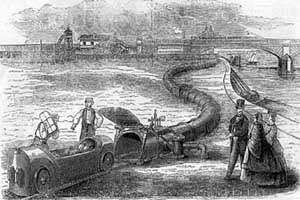
The picture shows the London Pneumatic Despatch Company's prototype. The capsule (left) is being loaded before being pushed into the pipeline (right). Between 1860 and 1874 the company started building a network of pipelines to transport freight across London. It started before any of the London Underground railway lines were built. Unfortunately the system was so slow and expensive the Post Office preferred to continue using carts. The pipeline was often flooded by the River Fleet, which caused the freight to arrive at its destination wet. The materials and technology used were not good enough. (picture source: Beach)
Pneumatic (air powered) capsule pipelines were invented by George Medhurst in 1810. He originally thought they would be used to transport people who would travel in capsules as large as railway carriages. He decided that people would not like travelling inside pipes and invented 'atmospheric' railways instead.
At the start of the 1800s the only way to send a message over a long distance was by posting a letter. Around 1850 the telegraph was introduced. This allowed messages to be sent over electric wires. In London, England, all messages from other towns and countries came to a central office, where they were written down.
Mr Latimer Clark built a capsule pipeline to transport cards (with the messages written on them) from the central office to the London Stock Exchange. Many of the messages were bound for the Stock Exchange. Messages were placed in small felt bags and transported through pipelines that were only 1 1/2 or 2 inches (about 5 cm) wide.
Over the next 100 years the pipeline networks were expanded. Pipelines linked local offices within large cities. Most large cities in Europe and Eastern America had these 'telegram conveyors', as the Victorians called them. They were well used until new ways of sending messages over telephone wires became available in the 1960s.
During the 1900s the capsule pipelines started to appear in large department stores in towns an cities, for moving money around.
The Victorians also built capsule pipelines for transporting passengers and freight within cities. These were not successful. Only one company (see right) built more than one route. Experimental passenger capsule pipelines were abandoned, and underground railways were built instead.
In the 1960s, 1970s and 1980s the technology used in pneumatic capsule pipelines was improved by people working in the U.S.S.R., Romanian, North America, Japan and England. New capsule pipelines were built to transport rocks and other minerals. These capsule pipelines work well, but they have only replaced other types of transport in a few places.
Think about it...
Victorian telegram conveyors were very important for transporting messages for over 100 years. Why do you think they have been forgotten? Did the people reading the telegram messages know how they had been transported? Did they need to know?
Larger Victorian capsule pipelines for transporting freight were unsuccessful because of the poor technology they were using. Do you think that if the Victorians had the technology we now have, they might have built more capsule pipelines? Could they have replaced trains, cars and lorries?